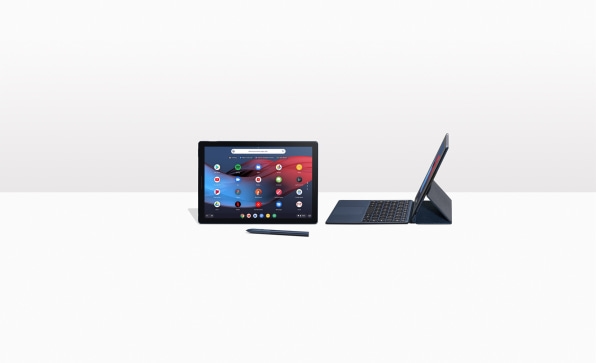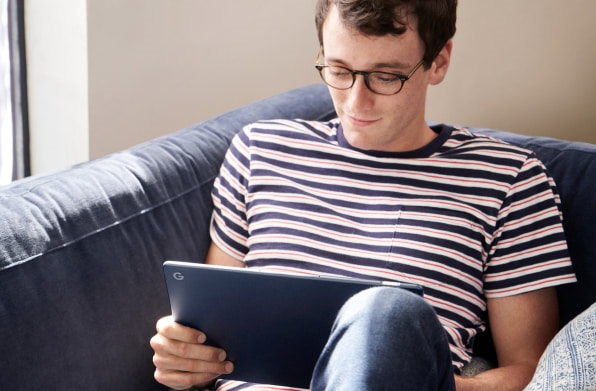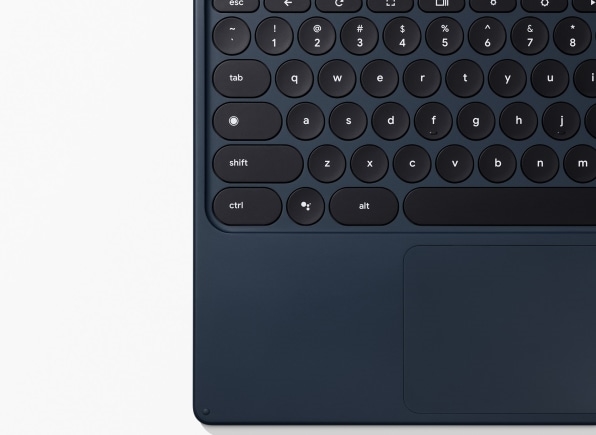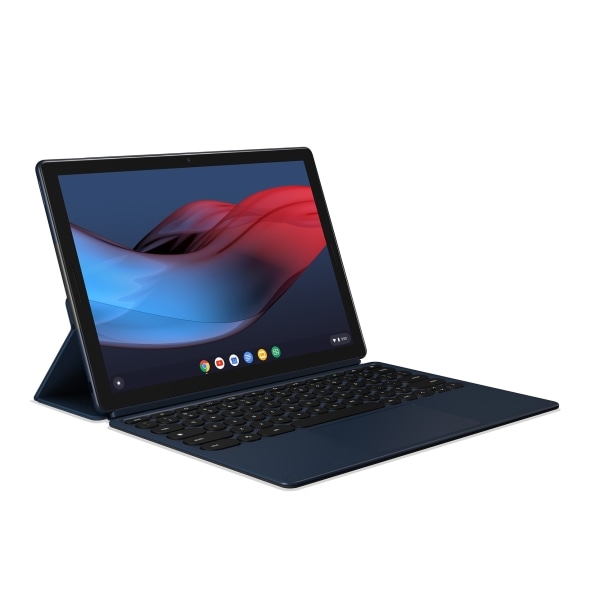Google’s Pixel Slate: Great Chromebook, not-so-great iPad/Surface rival
Since their 2011 launch, Chromebooks have been synonymous with low-cost, easily managed laptops that have strong appeal for education. But in 2013, when Google shipped the first Chromebook Pixel–a premium machine with a touchscreen–it became clear that the company was intent on exploring new frontiers for its browser-centric Chrome OS operating system.
Google’s new Pixel Slate tablet, which starts at $599, represents the culmination of those efforts. With its minimalist operating system and minimalist form factor, it’s the best pure web tablet ever made. But the Pixel Slate also offers the wealth of apps in the Google Play Store and accessories such as an optional keyboard and pen, putting it squarely in competition with Microsoft’s Surface and Apple’s iPad Pro. As with those devices, the message is that more is more, at least when you need it to be. However, Google still struggles to meld Chrome OS and Android in a way that feels natural rather than somewhat less than the sum of its operating-system parts.
A dark blue rounded rectangle that’s only 7mm thick, the Pixel Slate is thinner than the Surface Pro, but its 12.3? screen size and bezels provide the devices with almost identical heights and widths. While the Surface Pro has a full-size USB-A port, a Mini DisplayPort connector, and a magnetic power connector, the Pixel Slate has consolidated all those functions into two USB-C connectors, one on each side. I was able to easily connect and use the new Vinpok Split USB-C touchscreen monitor, although it couldn’t draw enough power from the Pixel and needed to be plugged into the wall. As with iPads, there’s no support for MicroSD storage cards and–like the most recent iPad Pros–no headphone jack. (Google does include a USB-C-to headphone-jack adapter in the box.)

[Photo: courtesy of Google]
Flanking the screen in landscape orientation are stereo speakers that provide good separation and acceptable volume, through the bass output is no better than you’d expect from such a thin frame. Both the front and rear of the device are equipped with eight-megapixel cameras capable of using Google’s impressive single-camera portrait mode, which pleasingly blurs backgrounds. A connector at the bottom of the device provides connection to Google’s keyboard folio case. And the device’s white recessed power button doubles as an effective fingerprint reader dubbed Pixel Imprint. Unlike the Surface Pro and iPad Pro, the Pixel Slate does not support face unlocking.
As the newest step in Chrome OS’ evolution to a touch-friendly design, the Pixel Slate is a hybrid of Google’s last two mobile computing devices, the Android-based Pixel C slate and the ChromeOS-based Pixelbook convertible.
In the tug-of-war for tablet strategy dominance between Apple and Microsoft that I wrote about recently, the Pixel Slate hews closer to the Surface approach, albeit with a few key differences. Like the Surface, it has access to a desktop-quality browser. In fact, using Chrome on a naked Pixel Slate is a similar experience to running any number of desktop browsers on an unadorned Surface Pro. At the Pixel Slate’s introduction, Google emphasized that it offered a full-powered browser as opposed to the watered-down version of Safari on the iPad or the Chrome version on Android; that said, you can use the Android versions of Firefox or Microsoft Edge on the Pixel Slate if you prefer.
Also like the Surface, the Pixel Slate can switch between a windowed desktop mode and a full-screen/split-screen-like iPad mode when its keyboard is removed or folded flat behind the display. However, while the Surface allows you to choose whether this happens automatically, manually or not at all, it is always automatic on the Pixel Slate.

Google may have more justification for the more aggressive switching. The Surface still suffers from Windows 10’s paucity of touch-optimized apps, but Google Play offers millions of apps that are touch-friendly, if not always well optimized for a tablet’s spacious screen. Chrome OS compatibility with Android apps has advanced significantly since Google first smooshed the two operating systems together in 2016, and I found relatively few Android apps that would not work. Historically, Android apps haven’t adjusted themselves well to a tablet’s landscape orientation; however, that’s less of a problem with the Pixel Slate, since Android apps can run in their own windows in desktop mode.
Indeed, Google cites Chrome OS support for multitasking–among other large-screen optimizations–as one of the reasons why it has shifted to that operating system as its lead tablet OS, deemphasizing pure Android tablets. And though many Android apps can look stretched out when used full-screen or even in a large window on the Pixel Slate, having access to them offers a number of advantages versus working solely in Chrome OS’s web browser. The Android apps for Uber, Instagram, and Venmo, for instance, are full featured; the websites for the same services are not. The Pixel Slate is ideal for social media managers wishing to see how their posts are progressing in various mobile apps while using a web-based management console. And of course, it also opens the Pixel Slate to millions of Android games.
Still, Android apps often feel more like supplemental applets in the Pixel Slate expanse; Google needs to do more to make them first-class citizens in Chrome OS. For example, in Google’s own Gmail and Google Docs apps, I wasn’t able to select text using the Shift key and the left or right arrow keys even though I could using other arrow key combinations; there was no such issue with the equivalent web apps. And Android home-screen widgets, Google’s Gboard keyboard, and custom Android launchers that offer options such as keeping apps alphabetized aren’t available in Chrome OS.
Conversely, now that Chrome OS is running on a touch-first device, Google could make it more finger-friendly–for instance, by making it easier to traverse between tabs by jabbing rather than clicking. Such enhancements would also pay dividends for Chrome on Windows and the iPad as well as touch-enabled Chromebooks.

The keyboard as companion
Given Chrome OS’s lineage as a laptop OS, Google’s $199 backlit keyboard folio is bound to be popular. It’s almost as critical an accessory as the Surface’s keyboard cover (and, like the Surface keyboard, includes a large trackpad). As with Apple’s keyboard folio for the latest iPad Pro, it wraps around the device, with a footprint that extends in the back to provide stability. It also has a signature feature in the ability of its support flap to easily slide up and down the back of the Pixel Slate, resulting in a greater range of angles and more fluid adjustability than Apple’s keyboard folio provides.
The Surface Pro’s kickstand, however, enables that device to be used at an even lower angle to whatever surface it’s on. Also, unlike the last few generations of Surface keyboard covers, the Pixel Slate Keytboard doesn’t let you attach it to the tablet at an angle, for a sloped typing surface. Some users may find the lack of that incline less comfortable, and it certainly resulted in more wobble when trying to use the Pixel Slate on my lap. That said, those with a yen for a more traditional, lap-stable laptop clamshell design might want to consider the G-Type keyboard for the Pixel Slate by Brydge. The accessory maker also supports various iPad and Surface models, but its Pixel Slate keyboard, which connects via Bluetooth, can fold behind the device like a convertible laptop.
Neither the folio nor the Pixel Slate itself offer a magnetic way to anchor Google’s $99 pressure-sensitive Pixelbook Pen. While the latest iPad Pro can even charge the Apple Pencil by snapping it to the device, Google’s stylus uses an old-school AAAA battery.
A whole lot of competition
The Pixel Slate packs a no-compromise browser experience in a package that is no thicker than it need be to support essential connectivity, at a starting price point between that of Apple’s most recent iPad and far below its luxe new iPad Pros.
On the other hand, there are Windows 2-in-1s. The comparably priced Surface Pro offers a more consistent user experience in a windowing environment, but one that comes at the expense of few touch-optimized applications, the need to wrangle software updates, and the girth to accommodate its kickstand and fan. And if you’re going all in on Google’s keyboard folio and pen, you’re also flirting with the price of Samsung’s more streamlined Windows-based Galaxy Book.

[Photo: courtesy of Google]
The Pixel Slate presages the kind of device Google hopes today’s generations raised on Chromebooks will embrace as they look to upgrade to something that boasts better mobility and panache. Despite its flexible handling of Google Play apps, a recent Android tablet from Samsung or Huawei may be a better option if you’re mostly interested in the Android experience and its wealth of apps.
Judged as a tablet, the Pixel Slate simply isn’t as compelling as when you use it in the far more mature, generally delightful Chrome OS desktop mode. If Google is serious about devices like this, it should encourage web developers to optimize more for touch screens, and Android developers to take better advantage of keyboards and trackpads. But the company has historically struggled to get developers to think about any environment beyond Android smartphones.
For now though, the Pixel Slate’s strongest competition within the Google ecosystem will come from inexpensive convertible Chromebooks. If using Chrome OS with a keyboard is your prevalent scenario–and it probably will be–they’ll accommodate your needs in a far less expensive package.
(18)

